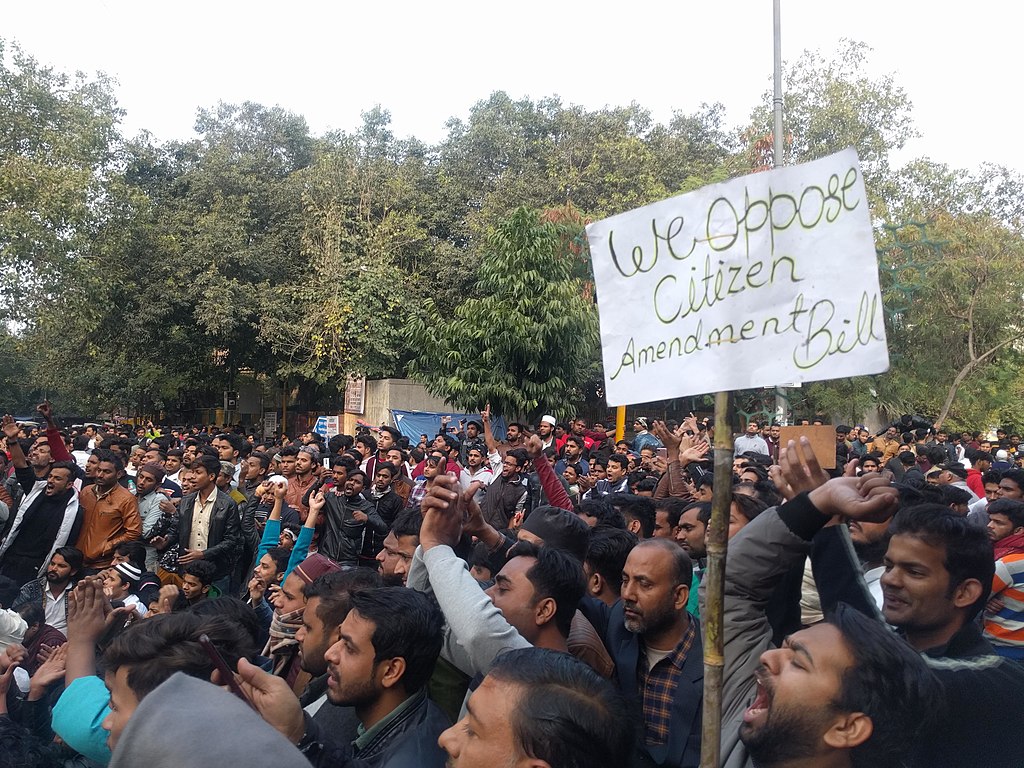India’s New Citizenship Law and its Anti-Secular Implications
What is the legal significance of India’s new citizenship law and why has it prompted protests on such an unprecedented scale?

Published by The Lawfare Institute
in Cooperation With

Over the past month, India has witnessed massive protests across the country against the passage of the Citizenship Amendment Act (CAA) by the Indian Parliament and the implementation of the National Register of Citizens. Initially, students led protests against the law and faced a brutal police response. Protests spread and the government relied on a colonial-era law to prohibit the gathering of more than four persons. Authorities shut off the internet in parts of the country, including various parts of the capital, New Delhi. Thousands of protestors have been arrested (many of whom were later released), and more than 23 have been killed in clashes with authorities. Despite this, people continue to gather in civil disobedience to protest. So, what exactly is the legal significance of the CAA, and why has it prompted protests on such an unprecedented scale?
The recently enacted CAA makes illegal migrants living in India from Pakistan, Afghanistan and Bangladesh who belong to Hindu, Sikh, Buddhist, Jain, Parsi and Christian religious communities eligible for Indian citizenship. The act notably excludes Muslim migrants.
The act’s exclusion of Muslims is consistent with the approach implicit in other recent measures taken to address the legal status of migrants in India. India is not a signatory to the 1951 Refugee Convention, nor does it have a domestic refugee law. So, individuals who enter India without valid documents or have incomplete or expired documents get classified as “illegal migrants.” Before other recent interventions, categorization as an illegal migrant made migrants ineligible to apply for Indian citizenship and made them subject to prosecution, deportation and imprisonment. Over the past few years, the Indian government has taken various steps to exempt individuals from these six non-Muslim religions from imprisonment and deportation. The government has also started to grant long-term-stay visas to migrants from these groups. These protections have not been extended to Muslims. (It should be noted, Muslims make up 14.2% of the Indian population).
The CAA takes this policy a step further and makes individuals from the six non-Muslim religious communities from Pakistan, Afghanistan and Bangladesh eligible for a fast-track path to Indian citizenship. The government’s stance is that these groups are persecuted religious minorities from their countries in need of refuge in India. Usually, to gain Indian citizenship by naturalization, a person needs to live in India for at least 11 of the previous 14 years. The CAA relaxes this 11-year requirement for the select group of “illegal” migrants to five years out of the previous 14.
Before India’s general election in mid-2019, the ruling Bharatiya Janata Party released its Election Manifesto, which reiterated the party’s commitment to enact a law to grant citizenship to religious minorities escaping persecution from neighboring countries. Within a few months of their reelection, the government introduced the CAA in Parliament. The government explains its motivations for enacting the law in the Statement of Objects and Reasons of the law. The statement argues that since the constitutions of Pakistan, Afghanistan and Bangladesh specify a state religion of Islam, individuals from the other religious communities in these countries face religious persecution that has caused many to flee to India. The government thus presents the act as a measure that allows these migrants to live and work in India.
During parliamentary debate on the CAA, the home minister claimed that the government is not taking away anyone’s rights but, rather, is granting rights to people in need. There is nothing objectionable about the new law, the home minister argued. He reasoned that the government is seeking to protect minorities from other countries in a way analogous to its efforts to protect and support minority communities within India.
In addition to religious affiliation, the CAA has a few other requirements for an illegal migrant to be eligible for citizenship, notably, country of origin. As mentioned above, the government’s explanation for selecting Bangladesh, Pakistan and Afghanistan is that those countries have a state religion (Islam), so religious minorities have faced persecution.
The government’s reasoning is puzzling because other Indian neighbors omitted from the law not only have a state religion but also have seen wide-scale persecution of religious minorities. For instance, Sri Lanka’s state religion is Buddhism, and there has been a history of persecution of the largely Hindu Tamil Eelam ethnic group; and Myanmar has a constitutional status for Buddhism and has led a now-infamous persecution of the Rohingya Muslims. A large number of refugees from these communities currently reside in India. If you take the government’s reasoning at face value, the omission of Myanmar and Sri Lanka from the ambit of the CAA is surprising. Additionally, choosing to limit the law’s reach to six non-Muslim religions means that the Indian government fails to provide a path to legal status for migrants from minority sects such as Hazarasas, and Ahmadiyas, and atheists from Bangladesh, Pakistan and Afghanistan. Why does a law, whose stated objective is to provide citizenship to individuals fleeing religious persecution, fail to protect threatened minorities from other neighboring countries or even certain groups from the act’s three specified countries?
The Indian Constitution embeds the principle of secularism and entitles every person in India, not only citizens, to the equal protection of the law. These are fundamental constitutional principles that any Indian law has to comply with. The principle of equal protection and treatment of the law prohibits the government from distinguishing between two groups of people unless the distinction is reasonable and nonarbitrary, and a clear purpose can be provided by the government for making the classification. The CAA plainly contradicts this important constitutional principle. While certain groups of people (Hindus, Sikhs, Buddhists, Jains, Parsis and Christians) from these three countries are granted immunity from being deemed illegal migrants and are given a fast track to Indian citizenship, another group of individuals (Muslims) from these countries will continue to be prosecuted as illegal migrants. In response to any potential challenge to the law before the Indian Supreme Court, it is unclear what constitutionally adequate rationale the government will provide for treating certain illegal migrants differently based on their religion.
There is another dimension to the protests across India—its implications for Indian citizens. Most centrally, protesters are worried about the combined effects of the CAA and the government’s controversial plan to create a National Register of Citizens (NRC). The basis for the NRC comes from both a 2003 amendment to the 1955 Citizenship Act and the rules issued in 2003 to operationalize the amendment. However, until recently, limited steps have been taken toward the implementation of the register. The NRC will reportedly require every individual across India to demonstrate that they are Indian citizens through certain specified documents. Under the NRC, individuals will have to show proof of their residence and date and place of birth as well as the citizenship of their ancestors, going back to a cutoff date specified by the government. In large parts of India, the people are poor and illiterate and lack the kind of documents that will be required to prove ancestry. Those from poor and marginalized communities will disproportionately bear the burden of the implementation of the NRC.
While there is no official link between the CAA and the NRC, there are concerns that the government is cloaking the CAA as empathetic and inclusive legislation protecting those illegal migrants who have faced religious persecution but that it will in fact be strategically used domestically to protect (presumably Indian) individuals from the six non-Muslim religions who may be excluded from Indian citizenship under the NRC. How would this work in practice?
The home minister has been reported to have said that once the CAA is implemented to give qualifying “illegal migrants” citizenship, the government will roll out the NRC to root out noncitizens. A permutation of the NRC has already been implemented in the northeastern state of Assam, and 1.9 million individuals ended up being left off the NRC, of which it has been reported that 1.2 million are Hindus and the rest Muslim. The exclusion of a significant number of these individuals was driven by the lack of appropriate documentation on behalf of those who are, in reality, Indian citizens. After they failed to provide documentation, these individuals were labeled “illegal migrants” and many have faced prosecution and imprisonment in detention centers. What damage will the sequential implementation of the CAA and the NRC cause?
Many observers fear that the dual regime of the CAA and the NRC creates a strange loophole for certain Indians who have been stripped of their citizenship and are seeking a path back to Indian citizenship. Individuals who are from one of the six non-Muslim religions and have been designated as noncitizens under the NRC process can seek citizenship through the recently passed CAA. This can potentially be done by their falsely claiming they are from Afghanistan, Pakistan or Bangladesh. Most illegal immigrants enter India without any valid documentation and, hence, have no clear way to prove their origin from a CAA-approved country. In recent years, the government has exempted individuals from the six non-Muslim religions and three CAA-approved countries from certain laws regulating their entry and residence and thus allows these migrants to stay in India “without valid documents.” Hence, it seems likely that officials compiling the NRC cannot expect anyone claiming protected status under the CAA to show extensive documentary proof of their origin from one of the approved countries. In fact, the home minister in an interview has stated that individuals from the six non-Muslim religions will get citizenship and the government will not ask for any documents.
It remains to be seen what rules and procedures the government will specify for the CAA process, but prior measures indicate that there will potentially be a lower threshold of proof for these individuals to establish, and consequently enable them to gain, Indian citizenship. However, this loophole is unavailable for Muslim individuals left off the NRC. For Muslim Indians who fail to make it on the NRC, there is no alternate path and they will be stripped of Indian citizenship. Thus, a combined reading of the CAA and the NRC results in a discriminatory process for Indian Muslims, who are on average already poorer and more marginalized than their Hindu counterparts.
What will the government do with individuals designated as illegal migrants? They will face prosecution, deportation and detention. Detention centers are being built at several locations across India to house these illegal migrants—likely including those Muslim Indians who do not qualify for the NRC. Because of the lack of deportation agreements with some neighboring countries (and the fact that many of those likely to be detained have, in fact, lived their entire lives in India), it is unclear how India plans to deport illegal migrants identified under the NRC exercise. For instance, India does not have any bilateral agreement in place to deport illegal migrants from Bangladesh and the Indian government usually ends up pushing illegal migrants across the border. However, it is a porous border and those pushed across the border often just come back in. The larger question is what will happen to individuals who are Indian citizens and have been stripped of their citizenship because they were unable to provide adequate documentation in the NRC process. Does the government plan to have these individuals languish in detention camps?
More than 59 petitions challenging the constitutionality of the CAA have already been filed before the Indian Supreme Court. In mid-December 2019, the Supreme Court issued notice to the federal government on these petitions and has set Jan. 22 as the date to start examining the constitutional validity of the law. Meanwhile, the provisions of the CAA have gone into effect. Joining individuals and political parties who have challenged the CAA, on Jan. 14, the Indian state of Kerala filed a petition in the Supreme Court challenging the constitutionality of the CAA. Some experts worry about the Indian Supreme Court’s ability to hold the government accountable given the Court’s recent pattern of deference to the government.
Some Indian states have opposed the implementation of the CAA and others have refused to implement the National Population Register, the exercise that will form the basis of the NRC. However, given the structuring of Indian federalism, it is unclear to what extent states will be able to refuse to implement a federal law.
Despite mixed statements by key government leaders over the past few weeks on whether there will be a nationwide implementation of the NRC, in late December, the Indian Cabinet has cleared US$550 million to update the NPR, an update previously described by the government census organization as the first step in the creation of the NRC.
Every signal seems to point to a combined implementation of the NRC and the CAA, a challenge to India’s secular and democratic foundations. By introducing religion as a criterion for the grant of Indian citizenship and effectively identifying only one religion as a persecutor, the CAA has set the stage for India’s transformation into a majoritarian state. The most powerful check on this burgeoning majoritarianism will come from the protest movement that has arisen in response to the Indian government’s actions. Several hundred thousand Indians are day after day peacefully protesting the CAA and the NRC, in the face of arrests and police violence. The protestors have positioned themselves as defending India’s secular origins by jointly reciting aloud the preamble to the Indian Constitution, “We, the people of India, having solemnly resolved to constitute India into a sovereign socialist secular democratic republic and to secure to all its citizens





